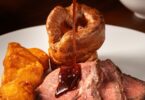Cathy Erway
As a child, Elmer Melendez Martinez often snacked on crabmeat from the claws that his mother and aunts brought home from their jobs picking blue crabs in the US state of Maryland. Though the steamed vermilion legs and prickly claws hold succulent meat for those with the patience to extract it, they are often discarded in the crabmeat industry in order to prioritise its most prized offering: lump crabmeat. These tender pillows of white fin meat – graded lump or jumbo lump, the latter even more a luxury – are carefully packed and sold fresh. Though exact numbers are hard to come by, a great deal of the product is enjoyed in the form of crab cakes, a Maryland signature.
Today, Melendez Martinez is the sous chef at Stars restaurant at the Inn at Perry Cabin in St Michaels, Maryland, where he prepares crab cakes with seasonal accoutrements such as autumn squash, pomegranate and brown butter. Though he’d never had a crab cake before working at the restaurant in 2019, he quickly fell in love.
[jump to recipe]“Crab makes up 40% of our total sales, which is astronomical,” said Gregory James, executive chef at Stars. Caught in the same river that guests admire from the windows of the dining room, it’s a hyper-local product and one of the primary money-makers in the Chesapeake Bay Watershed, supporting the local fishermen. “It really speaks to Maryland. When people come here, they want to have crab.”
The word “cake” in the name might be misleading; a true Maryland crab cake is very light on any ingredient besides pure picked crabmeat. A beaten egg, mayonnaise and light sprinkle of breadcrumbs just barely bind the pieces together, and the only other guests allowed at this crab cake-making table are fresh herbs (Stars uses chopped chives, parsley and lemon zest) and spices (like Old Bay seasoning, another Maryland signature). Once formed into patties, a quick roast or pan-fry kisses the exterior with texture and toasty flavour.
Crab has been enjoyed by Indigenous peoples in the Chesapeake Bay for more than 3,000 years, according to a study in Journey of Archaeological Science. And the crab cake is a rustic delicacy that’s been enjoyed for more than a century in the US.
“Just like lobster, crab started off as being garbage food of the peasants, and then aristocrats realised how good it was,” said James.
The same crabmeat mixture used for crab cakes is prepared in many ways at Stars – in crab eggs benedict, tortellini, crab imperial, crab fingers, crab bites and a hearty crab cake sandwich listed on the menu as the “Maryland Crab Sammy”. Garnished with tomato, spinach and lemon aioli and served on a brioche bun, it’s made every day the restaurant is open by Margarita Galdamez, a cook who has been employed at the 19th-Century inn for 18 years.
She’s gathered a few tricks of the trade over that time: first, the mixture should be very gently mixed so as not to break up the plump morsels of crab meat. “I do it with my hands but very carefully,” said Galdamez (through a translator from Spanish). “I like to let the mixture cascade through my hands over a bowl.”
Another tip is to leave the crabmeat out on a paper towel-lined sheet pan, uncovered, in the refrigerator for a couple of hours or overnight. This will air-dry the crab meat and make the cakes lighter and fluffier.
But be sure to use your crabmeat soon. According to the late chef and Southern cooking authority Edna Lewis, its freshness is fleeting: “Crabmeat has to be so fresh that it smells like the sea,” Lewis wrote in her 1988 cookbook In Pursuit of Flavor. She advises keeping it on ice as soon as you bring it home from the market and never freezing, which will ruin its texture. And like the chefs at Stars diligently do, always pick through it for shells. “Even if it cost fifteen dollars a pound [£12 for 450g] and the fishmonger insists it is clean, pick it over,” she wrote.
Nowadays, lump crabmeat easily costs three times that, anywhere from $40 to $60 per pound (£32 to £48 for 450g). But the reward for your trouble and money is a product that hardly needs any seasoning. Southern cooks like their crabs minimally fussed with so as not to overpower its delicate flavour. This makes a crab cake – or crab cake sammy – an ideal weeknight splurge of a meal.
For all the crab they churn out at Stars, the cooks never get tired of it, said Melendez Martinez. “Still love it. Still eat it as much as I can. My mom still brings it home and I can’t get enough.”
Stars’s Maryland Crab Sammy is garnished with tomato, spinach and lemon aioli and served on a brioche bun (Credit: Gregory James)
Maryland Crab Sammies recipe
Recipe courtesy of Stars restaurant at the Inn at Perry Cabin
Makes 4
Method
Step 1
Drain the crabmeat on a baking sheet lined with paper towels and refrigerate uncovered for two hours, or preferably overnight.
Step 2
Very carefully look for shells and remove if found (using a black light will help).
Step 3
Preheat the oven to 200C/400F. In a large metal bowl, whisk together the egg, mayonnaise, Old Bay, chives and lemon zest. Sprinkle in the panko and mix gently to absorb.
Step 4
Using your hands, very gently fold in the crabmeat without breaking up the pieces. Be careful not to overmix and stop as soon as the mixture appears somewhat evenly distributed.
Step 5
Form the mixture evenly into four cakes in the shape of a hockey puck, roughly 113g (4oz) each. If available, pack them tightly into moulds. Place the formed crab cakes on a baking sheet. Bake for 6 minutes, or until the internal temperature is 75C/165F.
Step 6
To assemble, coat each half of the cut brioche bun with ½ tablespoon of the lemon aioli. Add a tomato slice and some spinach leaves to the bottom of each bun. Top each with a crab cake, then close the bun and serve.
Courtesy: BBC







